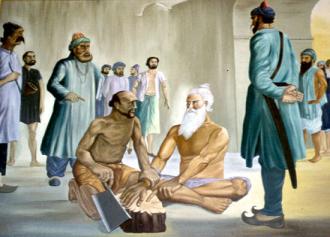Bhai Mani Singh Ji
Bhai Mani Singh was born on 10th March 1664 in village Alipur. Alipur is in district of Muzaffargarh, Multan in Pakistan. His father’s name is Mai Das and he was a devotee Sikh. His name was Mani Ram and usually called Mania at home. His father took him to Guru Har Rai in 1657 at Kiratpur. By meeting him, Guru said that Mania will be Gunia (virtuous). He stayed for 2 years in the service of Guru and got the teachings as a Sikh. In 1659, he returned to his home and got married to Bibi Sito Devi, the daughter of Lakhi Rai. After marriage, he returned to Guru Ji at Kiratpur and started learning Gurbani and giving his services in Langar. Guru Harkrishan succeeded Guru Har Rai. Bhai Mani Singh accompanied Guru Harkrishan on his visit to Delhi.

After Guru Harkrishan, Guru Tegh Bahadur becomes Guru. Bhai Mani Singh went to Baba Bakala and started serving Guru Teg Bahadur. He also accompanied Guru at Kiratpur and Anandpur. After the martyrdom of Guru Teg Bahadur, Bhai Mani Singh started to serve Guru Gobind Singh Ji. Bhai Mani Singh was a great preacher, writer, and brave fighter. His qualities made him an important person in Guru Sahib’s Court. In September 1688, he took part in the battle of Bhangani in defense and defeated the Hindu kings of the hills. He was a very respectful individual among Sikhs. In 1690 he fought against Mughals at Nadaun and won. In 1691, Guru Sahib appointed him as his Diwan (minister). In 1695, Mughal commander Husain Khan attacked Anandpur Sahib and got defeated in a battle in which Bhai Mani Singh took part. After, Guru Ji sends him to Ramdaaspur (now Amritsar) as a head priest after the death of Sodhi Har Jee. He managed the affairs very efficiently and effectively. Guru Ji recognized his hard work by giving him a letter of appreciation. In 1699, when Guru Ji brought Khalsa in front of the world, Bhai Mani Ram also took Amrit (got baptized) with his five sons and becomes Bhai Mani Singh. During 1704 Anandpur Sahib was surrounded by the combined forces of Hindu kings of the hills and Mughals. Guru Ji left Anandpur Sahib in December 1704, Bhai Mani Singh escort Mata Sunder Kaur and Mata Sahib Kaur to Delhi.
As a person, he was the most learned Sikh among the followers of Guru Ji. Due to his intelligence and skills, he got a place among 52 court poets of Guru Ji. He joined Guru Ji at Takhat Damdama Sahib Talwandi Sabo in 1706 where Guru Ji edited current version of Guru Granth Sahib Ji. Bhai Mani Singh got the honor of transcribing Guru Granth Sahib and he prepared a copy of Guru Granth Sahib which contained compositions of Guru Tegh Bahadur. He did it under Guru Ji’s guidance. He transcribed many copies of Guru Granth Sahib Ji for distribution. He uses to interpret Gurbani among Sangat. He also went far-off sites for preaching the teaching of Sikh Gurus.
After the martyrdom of Baba Banda Singh Bahadur in 1716, dissension broke out between the Sikhs and was split into two. One was Bandai Khalsa and other Tat Khalsa. Both wanted the control of Amritsar. So it was a great possibility of a mutual fight. As a head Granthi of Darbar Sahib at that time Bhai Mani Singh tactfully used his influence and wisdom to bring peace between both groups in 1723. As head of Darbar Sahib, Bhai Mani Singh used to call the general gathering of Sikhs two times a year to build moral and mutual understanding of Khalsa for strength. This gathering used to be held during Diwali and Vaisakhi.
Zakria Khan was a fanatic Muslim and was the governor of Lahore from the year 1726. He strictly prohibited Sikhs to visit Amritsar and restricted them to have a dip in the holy tank of Darbar Sahib. For this purpose, he deputed Lakhpat Rai (a Hindu) who hates Sikhs a lot. He did not allow Sikhs to assemble and celebrate Diwali at Darbar Sahib. He agreed to permit the Sikhs to gather at Darbar Sahib on Diwali if Bhai Mani Singh pay him 10000 rupees. 5000 rupee was to given in advance and 5000 after. Bhai Mani Singh gave the advance of 5000 rs and send an invitation to the Sikh groups to gather at Amritsar. After that Bhai Mani Singh came to know the exact purpose of the Governor. The Governor was in a plan to kill Sikhs as they gather at Amritsar from all the secret places. The troops were on the way from Lahore under the command of Lakhpat rai (a Hindu working under governor) brother of Jaspat Rai. When Bhai Mani Singh came to know about this, he send messages to all Sikh groups and told them not to gather. Most of the Sikhs, who were living in groups, got his message but those Sikhs who were living individually could not get the message and came to Amritsar and got killed by the governor’s forces. Consequently, the collected money was not enough to pay the governor. So the governor arrested Bhai Mani Singh for not paying the amount which the governor demanded. He was asked to embrace Islam as he couldn’t pay the money. Bhai Mani Singh refused to accept Islam and leave Sikhism. Governor told Bhai Mani Singh that if he does not accept Islam he would be killed by cutting into pieces, limb by limb. Bhai Mani Singh accepted death instead of changing his religion. When the executioner was going to cut the hand of Bhai Mani Singh, at that time Bhai Mani Singh remind him that the order is to execute by cutting limb to limb, so do your duty properly. This was to remind him of his duty as well as to prove that tyranny of any kind can’t destabilize a Sikh from the path of truth. Then Bhai Mani Singh was cut limb to limb by starting from fingers of the right hand. His fingers were also cut from the joints, like three cuts to every finger. While execution, Bhai Mani Singh kept on reciting Gurbani. He won martyrdom on 24 June 1734. He was 90 years old at that time. There stands Gurdwara Shaheed Ganj at Lahore at the same place.
On that day, Bhai Mani Singh was not only to get executed on that day. There were other Sikhs along with him to attain martyrdom. They were Jagat Singh(Brother of Bhai Mani Singh), Bhai Mani Singh’s son Bhai Chitar Singh & Bhai Gurbaksh Singh, Bhai Guljara Singh (he was executed by cutting limb by limb and after they took his skin off), Bhai Sangat Singh, Bhai Ran Singh, Bhai Bhupat Singh (he was executed by taking his eyes out and was executed by Charakhri, which is a set of big wheels having iron blades on them, which start ripping off the flesh when operated), Bhai Aulia Singh and Bhai Mokam Singh (son of Seth Ohri Mall. Mohkam Singh’s brother fought against Sikhs and got died fighting against Bhai Tara Singh Waan in 1709. These Sikhs are traceable through the family tree. From other sources, we got information of more Sikhs like Sharda Singh, Gurmukh Singh, Kahan Singh, Karam Singh, Chain Singh were also in those Sikhs to attain martyrdom on that day with Bhai Mani Singh.
He was not the only person to attain martyrdom in his family. Let’s have a look at his family members’ contribution to their faith. His grandfather Balu Ram was a devotee Sikh and attained martyrdom while fighting for Guru Hargobind Sahib Ji on 13th April 1634. Elder brother of Bhai Mani Singh was Bhai Dayal Daas was tortured and executed at Delhi followed by martyrdom of Guru Tegh Bahadur in 1675. Younger brothers of Bhai Mani Singh named Hathi Chand, Lehna Singh and Sohan Singh attains martyrdom while fighting for Guru Gobind Singh Ji. His five sons named Bhai Bachitar Singh, Ude Singh, Anik Singh, Ajaib Singh, and Ajub Singh win martyrdom in 1705 while fighting against Mughals. Bhai Mani Singh’s father-in-law Lakhi Rai cremated the body of Guru Teg Bahadur by taking risks of his and his family’s life. In 1734 along with Bhai Mani Singh, his sons Bhai Gurbax Singh and Bhai Chitar Singh and his brother Jagat Singh attained martyrdom.
